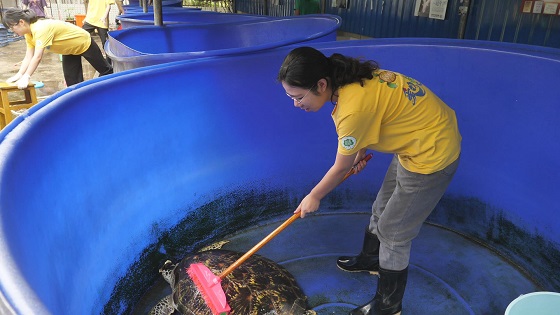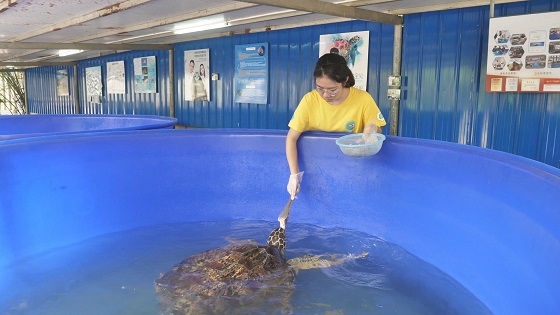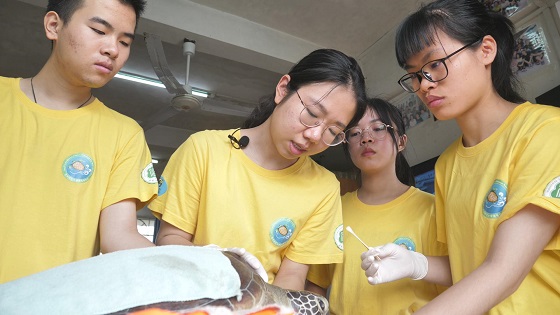"Originally, I became a volunteer because I was interested in sea turtles. I thought they were very cute, and I wanted to help them. Now, I continue to do it because it is my responsibility." Xie Zhenzi is currently in charge of student volunteers at Hainan Normal University’s Sea Turtle Rescue Station. In 2020 the Station released eight turtles back out into the sea. Being able to see the previously injured turtles restored to good health and swimming free makes the members of the Station very proud.
Attracted by the “Adorable” Turtles; Proud to Help Heal and Release
"The first time I saw a sea turtle, I thought it was very cute, very gentle."Xie Zhenzhi explained that her relationship with sea turtles started at her first year at the Hainan Normal University. Some of the older students took the first year students to visit the Sea Turtle Rescue Station with the goal of explaining the current situation at the Station to them. It didn't take much persuasion on their part to attract her interest in sea turtles and get her to join the Sea Turtle Rescue Station as a volunteer.
As Xie Zhenzi explained to the reporter, sea turtles are one of the marine ecosystem's "umbrella species". This means that the needs of their living environment cover the needs of other species like a protective umbrella. The act of protecting sea turtles serves to also provide protection for other species. For example, coral reefs are one of the sea turtle's important habitats. As protecting sea turtles means protecting the coral reefs, it also means invisibly protecting the small fish, shrimp, and other species who call the coral reef home.
"In total there are more than 200 students who volunteer at the Sea Turtle Rescue Station. All of them love the work of helping protecting sea turtles and helping protect the ocean. However, there are only 14 core volunteers who carry out the daily work of caring for the turtles at the Station." Xie Zhenzi told the reporter that the Sea Turtle Rescue Station is currently home to 15 turtles of whom 2 or 3 are actively receiving medical treatment. Turtles come to the Station via various means such as being found by citizens after they were stranded or being rescued from poachers by the Bureau of Fisheries.
At the time sea turtle was found, volunteers will carry out various inspections ranging from a medical health check to looking to see if the turtle is one which has previously been tagged. Every turtle who passes through the Rescue Station will be tagged prior to release back into the wild. Therefore, if a turtle is already tagged, they have a easy and accurate way to check its medical history. This makes it much easier for the volunteers and experts to treat their guests. If the turtle has not previously been tagged, they will open a file on it with information such as apparent age and current condition.

All of the Turtles that the Volunteers Feed and Take Care of Have Been Given Cute Names
"The way that sea turtles eat is very different from other animals. It's kind of funny. Food and water are swallowed at the same time, then the excess water is drained out through its nose," said Xie Zhenzhi, "Each turtle likes to eat different things. Some of them are prefer vegetables. Others prefer meat. Still others are like fussy children." The sea turtles are usually fed carrots, cucumbers, kelp, ocean fish, and clams. Additionally, they also put some vitamin supplements into the food.
In addition to feeding sea turtles, volunteers are also responsible for tasks like gently scrubbing the turtle's shells, and changing their water on a weekly basis. Because sea turtles are marine creatures, there are dedicated personnel who get seawater from the seaside and who carry out simple sedimentation and filtration of the water before sending it to the Station. This ensures that the guests of the Sea Turtle Rescue Station have a comfortable "home like" environment during their stay. Xie Zhenzi told the reporter that gently scrubbing the turtles is actually a way of doing a medical check-up. It not only helps to keep the turtles clean in the restrictive environment of the Station but provides an opportunity to see if there are any wounds or whether previously noted wounds are healing.
Every turtle who comes in to the Sea Turtle Rescue Station is given an adorable name such as Fruit, Fatty, Red Maple. "The name chosen by the volunteers have some kind of meaning to them. For example, there was one turtle who was given the name Kunpeng after the leviathan of Chinese mythology. Like its namesake, we hope it will be able to travel thousands of miles one day. We also hope to be able to return it to the sea as soon as possible." Xie Zhenzi told the reporter that after living with the volunteers day and night, it seems as if the turtles come to know them. "Whether we’re just walking by, or calling them by the names, they'll swim up to us. This is super helpful in terms of checking up on them and feeding them."

Emergency Treatments for Stranded Sea Turtles; Protecting the Ocean is Everyone’s Responsibility
On the day of the interview, the reporter had the opportunity to meet a particularly special resident of the Station. Called "Buli", it was a beached turtle found by a child playing on the shore. At the time Buli was found, it had an already healed over lost forelimb.
"When Buli first came to us, the amount of time he'd been beached was already way too long. So much time out of water meant that it was in very poor health. Its eyes were also infected and swollen shut." As Xie Zhenzi explained to the reporter, with regards to this matter, volunteers urgently arranged infusions to give Buli nourishment and to rehydrate it. While it was getting its IV, they also regularly spritzed it with water to help moisturize its skin. They also used medicated cotton swabs to remove the goo from around its eyes and gave it eye drops.
After a period of time, Buli finally opened its eyes and saw the world again. Nowadays, it is gradually recovering its health and is at the point of being able to slowly swim in shallow water.
"Those of our guests who have been restored to health will be released back out into the wild to their home in the ocean." Xie Zhenzi told the reporter that, as of now, the Sea Turtle Rescue Station has treated a total of 97 turtles and Station's team of volunteers has been slowly expanding.
She is of the opinion that this is a far cry for enough if they really want to protect the turtles. "There's a lot of protection work for sea turtles that doesn't require professional knowledge or skills. In fact, just working to reduce marine pollution is a way in which everyone can help to protect the turtles. I really hope more people will join us, in the goal of protecting the sea turtles and protecting the ocean."

(Photo by Chen Mingwen)






















